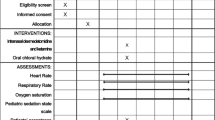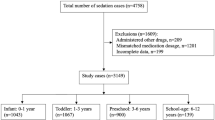Abstract
Sedation is often required for children undergoing diagnostic procedures. Chloral hydrate has been one of the sedative drugs most used in children over the last 3 decades, with supporting evidence for its efficacy and safety. Recently, chloral hydrate was banned in Italy and France, in consideration of evidence of its carcinogenicity and genotoxicity. Dexmedetomidine is a sedative with unique properties that has been increasingly used for procedural sedation in children. Several studies demonstrated its efficacy and safety for sedation in non-painful diagnostic procedures. Dexmedetomidine’s impact on respiratory drive and airway patency and tone is much less when compared to the majority of other sedative agents. Administration via the intranasal route allows satisfactory procedural success rates. Studies that specifically compared intranasal dexmedetomidine and chloral hydrate for children undergoing non-painful procedures showed that dexmedetomidine was as effective as and safer than chloral hydrate. For these reasons, we suggest that intranasal dexmedetomidine could be a suitable alternative to chloral hydrate.
Similar content being viewed by others
References
Roback NG, Carlson DW, Babl FE, Kennedy RM. Update on pharmacological management of procedural sedation for children. Curr Opin Anasthesiol. 2016;29:S21–35.
Sulton C, McCraken C, Simon HK, Hebbar K, Reynolds J, Cravero J, et al. Pediatric procedural sedation using dexmedetomidine: a report from the Pediatric Sedation Research Consortium. Hosp Pediatr. 2016;6:536–44.
Haselkorn T, Whittemore AS, Udaltsova N, Friedman GD. Short-term chloral hydrate administration and cancer in humans. Drug Saf. 2006;29:67–77.
Pershad J, Palmisano P, Nichols M. Chloral hydrate: the good and the bad. Pediatr Emerg Care. 1999;15:432–5.
Napoli KL, Ingall CG, Martin GR. Safety and efficacy of chloral hydrate sedation in children undergoing echocardiography. J Pediatr. 1996;129:287–91.
D’agostino J, Terndrup TE. Chloral hydrate versus midazolam for sedation of children for neuroimaging: a randomized clinical trial. Pediatr Emerg Care. 2000;16:1–4.
Valenzuela DG, Kumar DS, Atkins CL, Beers A, Kozak FK, Chadha NK. Chloral hydrate sedation for auditory brainstem response (ABR) testing in children: safety and effectiveness. Int J Pediatr Otorhinolaryngol. 2016;83:175–8.
Stephen MC, Mathew J, Varghese AM, Kurien M, Mathew GA. A randomized controlled trial comparing intranasal midazolam and chloral hydrate for procedural sedation in children. Otolaryngol Head Neck Surg. 2015;153:1042–50.
Sury MR, Hatch DJ, Deeley T, Dicks-Mireaux C, Chong WK. Development of a nurse-led sedation service for paediatric magnetic resonance imaging. Lancet. 1999;353:1667–71.
Hare M. Question 1. Chloral hydrate or midazolam: which is better for sedating children for painless diagnostic imaging? Arch Dis Child. 2012;97:750–2.
Buck ML. The use of chloral hydrate in infants and children. Pediatr Pharmacother. 2005;11:1–4.
Nordt SP, Rangan C, Hardmaslani M, Clark RF, Wendler C, Valente M. Pediatric chloral hydrate poisoning and death following outpatient procedural sedation. J Med Toxicol. 2014;10:219–22.
Cotè CJ, Karl HW, Notterman DA, Wemberg JA, McCloskey C. Adverse sedation events in pediatrics: analysis of medications used for sedation. Pediatrics. 2000;106:633–44.
Mace SE, Brown LA, Francis L, Godwin SA, Hahn SA, Howard PK, et al. EMCS Panel on Critical Issues in the Sedation of Pediatric Patients in the Emergency Department Clinical policy: critical issues in the sedation of pediatric patients in the emergency department. Ann Emerg Med. 2008;51:378–99.
Rumm PD, Takao RT, Fox DT, Atkinson SW. Efficacy of sedation of children with chloral hydrate. South Med J. 1990;83:1040–3.
Malviya S, Voepel-Lewis T, Prochaska G, Tait AR. Prolonged recovery and delayed side effects of sedation for diagnostic imaging studies in children. Pediatrics. 2000;105:E42.
Mahmoud M, Mason KP. Dexmedetomidine: review, update, and future considerations of paediatrics perioperative and periprocedural applications and limitations. Br J Anaesth. 2015;115:171–82.
Wolfe TR, Braude DA. Intranasal medication delivery for children: a brief review and update. Pediatric. 2010;126:532–7.
Cimen ZS, Hanci A, Sivrikaya GU, Kilinc LT, Erol MK. Comparison of buccal and nasal dexmedetomidine premedication for pediatric patients. Paediatr Anaesth. 2013;23:134–8.
Faritus SZ, Khazaee-Koohpar M, Ziyaeifard M, Mehrabanian MJ. Oral dexmedetomidine versus midazolam as anesthetic premedication in children undergoing congenital heart surgery. Anesth Pain Med. 2015;22:e25032.
Tobias JD, Cravero JP. Procedural sedation for infants, children and adolescents. First ed. American Academy of Pediatrics section on Anesthesiology and Pain Medicine; 2016.
Tobias JD. Dexmedetomidine and ketamine: an effective alternative for procedural sedation? Paediatr Crit Care Med. 2012;13:423–7.
McVey JD, Tobias JD. Dexmedetomidine and ketamine for sedation during spinal anaesthesia in children. J Clin Anesth. 2010;22:538–45.
Akin A, Bayram A, Esmaoglu A, Tosun Z, Aksu R, Altuntas R, et al. Dexmedetomidine vs midazolam for premedication of pediatric patients undergoing anesthesia. Paediatr Anaesth. 2012;22:871–6.
US Food and Drug Administration. Safety Announcement: FDA review results in new warnings about using general anesthetics and sedation drugs in young children and pregnant women. 2016; Available at: http://www.fda.gov/downloads/Drugs/DrugSafety/UCM533197.pdf. Accessed 24 Jan 2017.
Disma N, Hansen TG. Pediatric anesthesia and neurotoxicity: can findings be translated from animals to humans? Minerva Anestesiol. 2016;82:791–6.
Sanders RD, Sun P, Patel S, Li M, Maze M, Ma D. Dexmedetomidine provides cortical neuroprotection: impact on anaesthetic-induced neuroapoptosis in the rat developing brain. Acta Anaesthesiol Scand. 2010;54:710–6.
Degos V, Charpentier TL, Chhor V, Brissaud O, Lebon S, Schwendimann L, et al. Neuroprotective effects of dexmedetomidine against glutamate agonist-induced neuronal cell death are related to increased astrocyte brain-derived neurotrophic factor expression. Anesthesiology. 2013;118:1123–32.
Li Y, Zeng M, Chen W, Liu C, Wang F, Han X, et al. Dexmedetomidine reduces isofluorane induced neuroapoptosis partly by preserving PI3K/Akt pathway in the hippocampus of neonatal rats. PLoS One. 2014;9:e93639.
Alam A, Suen KC, Hana Z, Sanders RD, Maze M, Ma D. Neuroprotection and neurotoxicity in the developing brain: an update on the effects of dexmedetomidine and xenon. Neurotoxicol Teratol. 2017. doi:10.1016/J.ntt.2017.01.001.
Mason KP, Zurakowski D, Zgleszewski SE, Robson CD, Carrier M, Hickey PR, et al. High dose dexmedetomidine as the sole sedative for pediatric MRI. Paediatr Anaesth. 2008;18:403–11.
Mason KP, Lubisch NB, Robinson F, Roskos R. Intramuscular dexmedetomidine sedation for pediatric MRI and CT. AJR Am J Roentgenol. 2011;197:720–5.
Mason KP, Lubisch N, Robinson F, Roskos R, Epstein MA. Intramuscular dexmedetomidine: an effective route of sedation preserves background activity for pediatric electroencephalograms. J Pediatr. 2012;161:927–32.
Yuen VM, Hiu TW, Irwin MG, Yuen MK. A comparison of intranasal dexmedetomidine and oral midazolam for premedication in pediatric anesthesia: a double-blinded randomized controlled trial. Anesth Analg. 2008;106:1715–21.
Jia JE, Chen JY, Hu X, Li WX. A randomized study of intranasal dexmedetomidine and oral ketamine for premedication in children. Anaesthesia. 2013;68:944–9.
Li BL, Zhang N, Huang JX, et al. A comparison of intranasal dexmedetomidine for sedation in children administered either by atomizer or by drops. Anaesthesia. 2016;71:522–8.
Mekitarian Fihlo E, Robison F, de Carvalho WB, Gilio AE, Mason KP. Intranasal dexmedetomidine for sedation for pediatric computed tomography imaging. J Pediatr. 2015;166:1313–5.
Baier NM, Mendez SS, Kimm D, Velazquez AE, Schroeder AR. Intranasal dexmedetomidine: an effective sedative agent for electroencephalogram and auditory brain response testing. Paediatr Anaesth. 2016;26:280–5.
Reynolds J, Rogers A, Medellin E, Guzman JA, Watcha MF. A prospective, randomized, double-blind trial of intranasal dexmedetomidine and oral chloral hydrate for sedated auditory brainstem response (ABR) testing. Paediatr Anaesth. 2016;26:286–93.
Miller J, Xue B, Hossain M, Zhang MZ, Loepke A, Kurth D. Comparison of dexmedetomidine and chloral hydrate sedation for transthoracic echocardiography, in infants and toddlers: a randomized clinical trial. Paediatr Anaesth. 2016;26:266–72.
Ambi US, Joshi C, Ganeshnavar A, Adarsh E. Intranasal dexmedetomidine for paediatric sedation for diagnostic magnetic resonance imaging studies. Indian J Anaesth. 2012;56:587–8.
O’Mara K, Gal P, Wimmer J, Ransom JL, Carlos RQ, Dimaguila MA, et al. Dexmedetomidine versus standard therapy with fentanyl for sedation in mechanically ventilated premature neonates. J Pediatr Pharmacol Ther. 2012;17:252–62.
Lam F, Bhutta AT, Tobias JD, Gossett JM, Morales L, Gupta P. Hemodynamic effects of dexmedetomidine in critically ill neonates and infants with heart disease. Pediatr Cardiol. 2012;33:1069–77.
Chrysostomou C, Schulman SR, Herrera Castellanos M, Cofer BE, Mitra S, da Rocha MG, et al. A phase II/III, multicenter, safety, efficacy, and pharmacokinetics study of dexmedetomidine in preterm and term neonates. J Pediatr. 2014;164:276–82.
Zhang W, Wang Z, Song X, Fan Y, Tian H, Li B. Comparison of rescue techniques for failed chloral hydrate sedation for magnetic resonance imaging scans—additional chloral hydrate vs intranasal dexmedetomidine. Paediatr Anaesth. 2016;26:273–9.
Gan X, Lin H, Chen J, Lin Z, Lin Y, Chen W. Rescue sedation with intranasal dexmedetomidine for pediatric ophthalmic examination after chloral hydrate failure: a randomized, controlled trial. Clin Ther. 2016;38:1522–9.
Zhang W, Fan Y, Zhao T, Chen J, Zhang G, Song X. Median effective dose of intranasal dexmedetomidine for rescue sedation in pediatric patients undergoing magnetic resonance imaging. Anesthesiology. 2016;125:1130–5.
Li BL, Yuen VM, Song XR, Ye J, Ni J, Huang JX, et al. Intranasal dexmedetomidine following failed chloral hydrate sedation in children. Anaesthesia. 2014;69:240–4.
Reynolds J, Rogers A, Capehart S, Manyang P, Watcha MF. Retrospective comparison of intranasal dexmedetomidine and oral chloral hydrate for sedated auditory brainstem response exams. Hosp Pediatr. 2016;6:166–71.
Gumus H, Bayram AK, Poyrazoglu HG, Canpolat DG, Per H, Canpolat M, et al. Comparison of effects of different dexmedetomidine and chloral hydrate doses used in sedation on electroencephalography in pediatric patients. J Child Neurol. 2015;30:983–8.
Authors’ contributions
All authors, SN, GC and EB, contributed equally to the manuscript. All authors, SN, GC and EB, read and approved the manuscript and approved its submission to the journal.
Author information
Authors and Affiliations
Corresponding author
Ethics declarations
Conflict of interest
The authors SN, GC and EB declare that they do not have any conflict of interest.
Funding
The authors, SN, GC and EB, declare they did not receive any funding or grant for this manuscript.
Rights and permissions
About this article
Cite this article
Cozzi, G., Norbedo, S. & Barbi, E. Intranasal Dexmedetomidine for Procedural Sedation in Children, a Suitable Alternative to Chloral Hydrate. Pediatr Drugs 19, 107–111 (2017). https://doi.org/10.1007/s40272-017-0217-5
Published:
Issue Date:
DOI: https://doi.org/10.1007/s40272-017-0217-5




